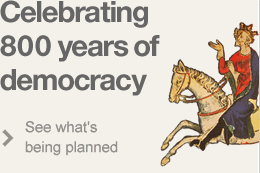The Provisions of Oxford of 1258 had criticised King Henry III’s policies and drafted new rules for the king to follow. A permanent council was set up to supervise the appointment and actions of the royal officers. Simon de Montfort, Earl of Leicester, was a leading member of the group. He was the leading advocate of restraints on the royal power. Henry’s efforts to subdue those reforms provoked a baronial faction led by Simon.
By the early 1260s England was in turmoil. Quarrels flared into civil war, culminating in the Battle of Lewes in May 1264. Although the armies were evenly matched, Henry was soundly beaten by Simon. The king himself was captured and Prince Edward became a hostage. Lewes had ended with negotiations which gave Simon and his allies increased power. They now ruled England in the name of the captive king. They tried hard to arrive at a lasting settlement and called parliaments in June 1264 and January 1265. Although the latter included fresh and innovative representative elements, both failed.
Simon’s support began to crumble with some fellow barons turning hostile and deserting him. Edward escaped in late May 1265. Roger Mortimer of Wigmore and the Earl of Gloucester joined him to form a royalist force. The civil war resumed.
Simon needed to unite with his supporters and tried to reach Kenilworth where his son, also called Simon, was assembling a force. Edward took the risk of leaving Worcester on a forced march to Kenilworth where he surprised the young Simon and seriously weakened his forces. On 3rd August Simon senior approached Evesham from the south to enter the town across the bridge close by the abbey. Edward now returned overnight from Kenilworth to confront and trap Simon in Evesham. On 4th August battle was joined. Despite being outnumbered more than three to one Simon rode out with his cavalry, with his infantry in support to engage the enemy.
Somewhere close to the summit of Greenhill he found the royal forces deployed in three divisions. Simon had no choice but to fight his way out. He deployed his army as a single column and charged at the junction between Edward’s and Gloucester’s troops. It was a desperate tactic which might have succeeded had not the cavalry wings of the royal army swung in on Simon’s flanks. Although the baronial army continued to resist for some hours the battle became a progressively bloody massacre. It appears likely that the infantry had already broken and begun to flee, but if not then, they were soon routed. Simon’s knights were soon encircled. Unusually, no quarter was given and most of Simon’s main supporters were cut down. Simon himself was surrounded, grounded from his horse and brutally put to death. His son Henry was also killed.
The rebel forces were pursued mercilessly back into the town, and the killing continued right through the streets and even inside the abbey itself.
The Battle of Evesham was a turning point: it had completely broken the rebellion. Almost all the major supporters had been intentionally killed on the field.
Written by Clive Bostle
Featured Article
Introduction – Runnymede and all that. Winston Churchill described the Magna Carta as “the foundation of principles and systems of government of which neither King John or his nobles dreamed”. Now in Politics we’re used to the law of unintended consequences...
Read on...Recent Articles
- Magna Carta's American Adventure
- 800th anniversary of Bristol...
- Bristol 800 concert and...
- Emancipation and Magna Carta
- Terrorism and Tolerance -...
- Magna Carta
- Magna Carta Benches mark...
- ABA Magna Carta Memorial...
Stay updated
If you would like to keep informed about the work of the Magna Carta Trust and our partners, please sign up to the newsletter below.
Become a Supporter
There are a number of significant supporter opportunities. Register your interest early to ensure the widest range of options.
Find out more




